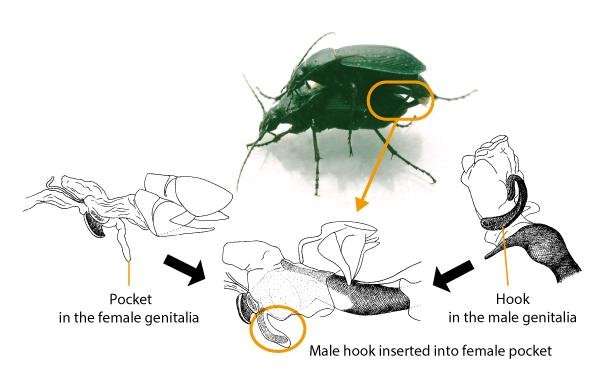Harassing females lowers reproduction rates and reduces population size

Males and females mate to produce offspring, but their relationships are not always cooperative. The conflict between the sexes when they behave selfishly can be negative for the whole group. A group of Japanese researchers found that when males of a species compete, the burden this places on females can cause a drop in reproductive ability and a decrease in population size. These findings were published in Evolution on October 4.
The research team was led by Associate Professor Yasuoki Takami (Kobe University Graduate School of Human Development and Environment), Professor Jun Yokoyama (Yamagata University Faculty of Science) and Professor Masakado Kawata (Tohoku University Graduate School of Life Sciences).
Sometimes, the stronger male in breeding-related competition between males is an inappropriate partner who hinders breeding. This is known as sexual conflict. Sexual conflict is a "relationship that cannot be optimized," in which males and females each try to maximize their own reproductive success. It has drawn attention as a driver of evolution, but the impact it has on important ecological processes such as changes in population size has not been closely studied.
The male ground beetle Carabus insulicola, the object of this study, has male genitalia with a fishhook-shaped hook, and the female genitalia has a pocket to receive the male genitalia. After facilitating the mating of beetle pairs with varying lengths of genitalia, the research team found that males with long genitalia caused females to release unfertilized eggs wastefully. Unfertilized eggs made up roughly 20 to 40 percent of the eggs laid by these females—eggs that would have been fertilized later by mating with other males. This can be a selfish action by the male, who tries to ensure his reproductive success relative to rival males. Because of this competition between males, the finite resources of eggs are wasted, and the reproductive success of the female is sacrificed.
Meanwhile, the team also showed that females with long reproductive pockets are more resistant to this sort of male harassment, and are able to maintain a higher ratio of egg fertilization. When they looked at the relationship between genitalia length of males and females and population size in multiple wild populations, they found that populations were smaller if they had characteristics that promote harassment (long male genitalia and short female genitalia).
This is a pioneering result that proves that antagonistic male-female relationships can have a negative impact on wild populations. Self-serving acts by individuals can damage the sustainability of society as a whole by draining resources—the so-called "tragedy of the commons." This study shows that such acts occur in wild populations through sexual conflict.
Associate Professor Takami says, "We hope that by introducing the perspective of sexual conflict, we will be able to improve our methods of gauging the survival chances of animal populations."
More information: Yasuoki Takami et al. Impact of sexually antagonistic genital morphologies on female reproduction and wild population demography, Evolution (2018). DOI: 10.1111/evo.13603
Journal information: Evolution
Provided by Kobe University



















